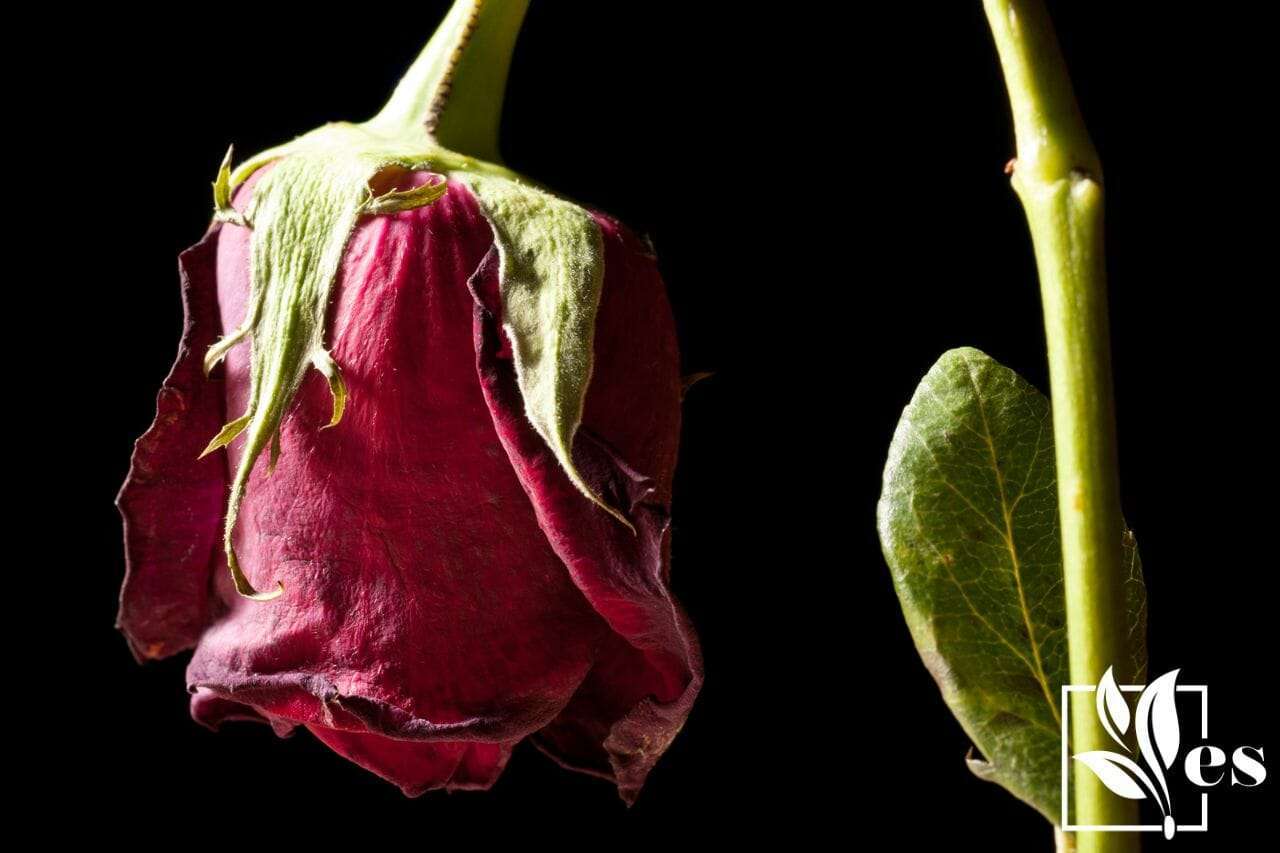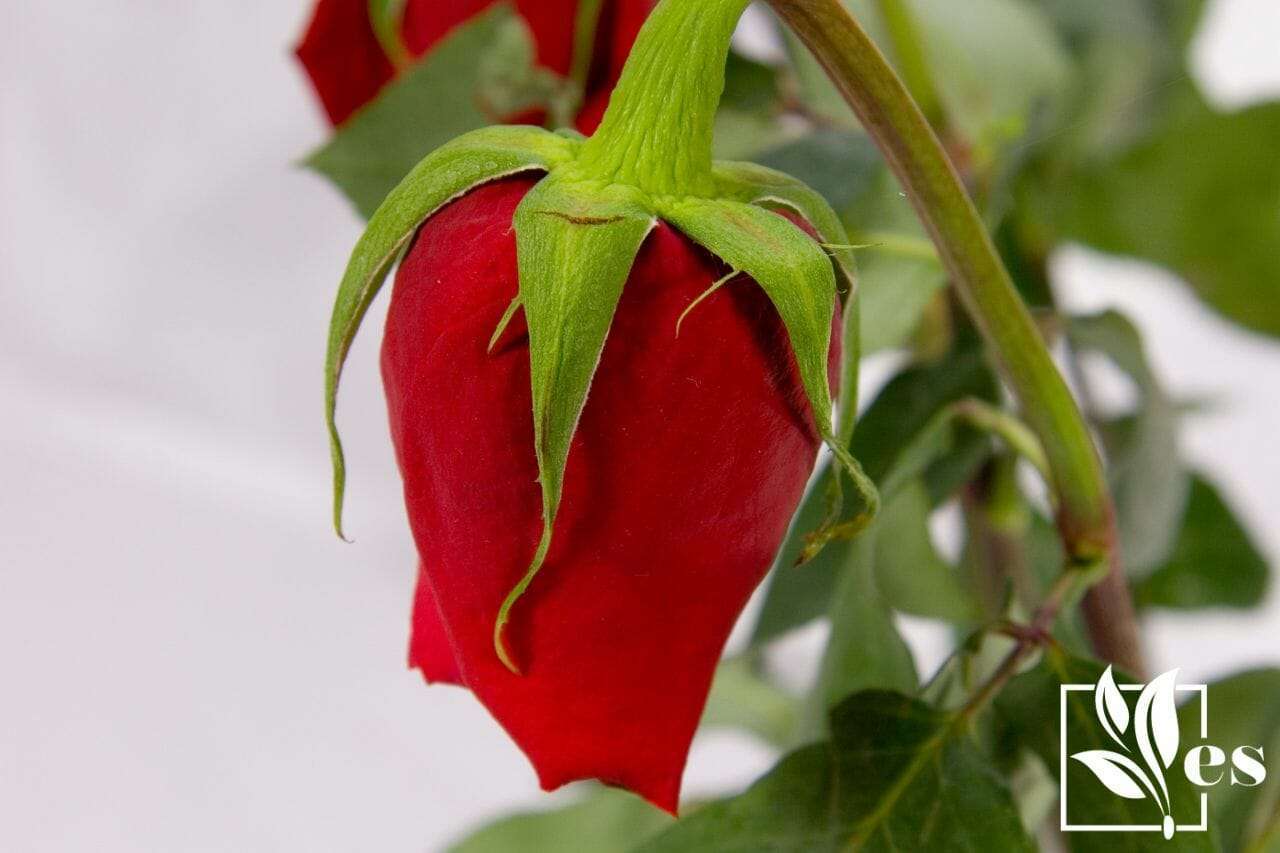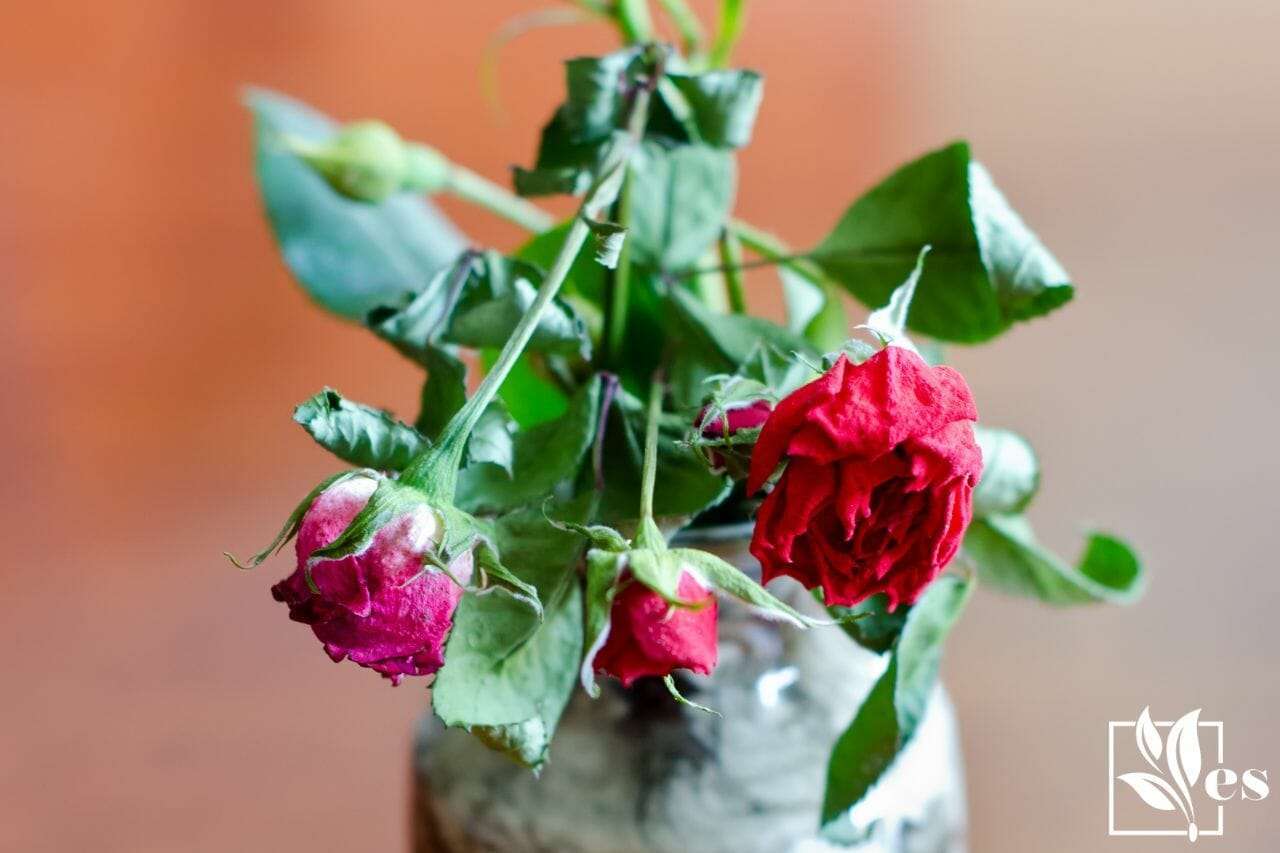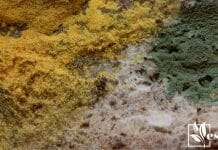Wilted rose may be quite a heart-breaking sight to see. Nobody wants to see their gorgeous rose plant suffering and losing its beauty. There is nothing to worry about, though, because this wilting is usually treatable.
 What you should do is keep reading our guide below to learn why are your roses wilting and the solution to how you may revive a wilted rose plant.
What you should do is keep reading our guide below to learn why are your roses wilting and the solution to how you may revive a wilted rose plant.
Why Is Your Rose Wilting?
💥 The number one cause why your rose might be wilting is watering issues. Both overwatering and underwatering might be responsible. Other probable causes might be transplant shock and temperature fluctuations. Lastly, you must see if diseases and pests like aphids, verticillium, and canker make your rose plant wilt.
– Underwatering
Underwatering is the number one reason why any plant starts wilting. If you have wilted peonies, wilted lilies, or roses, all you have to do is check their soil. If it feels dry beyond the first two inches, you have underwatered plants at hand. To check the soil, you can use a moisture meter, a pencil, a wooden skewer, or even your finger.
Roses are more susceptible to wilting by underwatering during hot summers. This is when the increased temperature and intense sunlight make the soil dry faster. If you don’t increase your frequency of watering accordingly, the plant will eventually suffer.
The quantity of water plays a role too. On average, a rose bush needs one gallon of water per week. If you use less water than this, the plant will naturally become dehydrated over time. Water with a large amount of salt also dehydrates the plant in the long run.
– Overwatering
Overwatering almost always leads to wilted roses. This can happen a lot if your soil doesn’t have proper drainage or if you don’t check the soil before watering. Overwatering is dangerous because it soon leads to root rot or the spot disease of rose flowers.
An overwatered plant gets clogged with water, and the leaves become swollen and begin to droop down. The whole plant starts to wilt under the weight of the excessive water. All this extra water prevents the right nutrients from reaching the plant leading to leaf chlorosis.
Roses grown in pots and containers are more at risk. With repeated watering, the drainage holes at the bottom of the pot get blocked with soil substrates, and this naturally allows water to get collected in the container. Even outside in a garden, if your soil is partly loamy without adequate drainage, it will get waterlogged easily.
– Transplanting Shock
Have you recently transplanted your plant from one place to another? If yes, then it will begin to wilt immediately afterward. Transplant shock is a physiological phenomenon and nothing to worry about. Once your plant establishes its roots in the soil, the wilted leaves will perk right back up.
Sometimes, the roots also get damaged during the transplant; unless the situation is pretty bad, this too gets resolved over time by itself. The only thing you can do is to be extra careful when transplanting your rose plant because many rose parts will be affected.
– Temperature Keeps Fluctuating
Your wilted primroses and roses might be suffering due to improper temperatures. Roses like to grow at temperatures above 80 degrees Fahrenheit, especially during spring and summer. However, they need to be watered adequately during this time too. Not watering on time or watering inadequately will cause them to wilt.
The same goes when the temperature starts dropping. Roses cannot survive below 32 degrees Fahrenheit. Frost and snow will cause them to wilt and drop all their leaves to conserve energy. Even indoor kept plants can suffer from such wilting if they are placed directly under a cold draft of air from an air conditioner.
Similarly, sudden fluctuations in temperature are not recommended for roses. You cannot just take these plants kept indoors in a controlled environment and put them out in the hot sun. They will immediately begin to wilt.
– Verticillium Wilt
Verticillium wilt is a serious fungal infection responsible not only for wilted roses but also for wilted hydrangeas and wilted hibiscus. It quickly destroys any plant it attacks and then jumps to the nearby plants, shrubs, and vines.
A clear tell-tale sign of verticillium wilt is that the leaves at the lower end of the stem will start yellowing first. The stem will begin to wilt and deform. The leaves that turned yellow will soon begin dropping too.
The fungi responsible for this infection are present harmless within the soil. They only affect the plant if the soil is overwatered and the roots rotten. They will attack the roots and start moving up the stem, wilting it.
– Aphids
Aphids are the most common pests among roses and other common houseplants. These are very small insects, barely one-quarter of an inch in size. Their colors, too, vary from green, brown, and black. All these factors make aphids elude your notice and destroy the plant before they are noticed.
Aphids feed on the sap providing food to the leaves. Over time they multiply to such a large extent that they cause the most severe malnutrition in the rose bush. Initially, only small yellow and brown spots appear on the leaves of the affected plant. You can remove your rose bush to separate it from all the other plants.
When an aphid infestation continues, the leaves start wilting first. This is followed by stem wilting. The flowers produced by the affected plant will be few and of very poor quality. The wilting roses will have spotted and wilted rose petals.
– Stem Canker Disease
Stem canker is a common fungal infection of the rose plant. It leads to the development of hard egg-shaped cankers on the plant’s stem. These cankers most commonly form the pruned stubs of the stems.
Cankers also develop on scars present on stems or leaf nodes. Consequently, all the leaves on the affected stem start wilting. Then they start dropping when the disease progresses a lot. The whole rose plant becomes disfigured.
Why does this disease develop? Rose plants love high humidity, around 60 to 70 percent. If the air circulation around the plant is compromised, it soon catches canker infection. Using infected tools without proper disinfection is the second most common cause.
– Root Rot
If you are not careful about overwatering, then your plant’s roots will soon begin to rot. Fungi will attack these rotten roots, and the disease will soon spread to the whole plant.
Apart from wilting, you will notice yellow, brown, and black moist rot spots. These spots will be present all over the plant. Soon enough, the sick plant will drop leaves one by one and die.
How To Fix A Wilted Rose Plant
To fix a wilted rose, you must treat the cause responsible for wilting, you must hydrate the plant, avoid overwatering it, and provide the right temperature so it blooms again. If it has verticillium wilts, treat them along with stem cankers and even root rots and get rid of aphids.
– Revive The Dehydrated Plant
It is very easy to revive a dry rose flower plant if it is planted in a container. All you have to do is to put this container in a bucket filled halfway with water. Let the water soak through the bottom of the pan to its surface. This will take about 10 to 15 minutes. After this, take the pot out and water diligently from now on.
If your roses are planted in the garden, use a large volume of water and start pouring. You will notice that the soil will keep absorbing water initially. Remember, stop watering when the surface finally begins to start glistening because you might have to use more than the standard one gallon of water when reviving a plant.
If you have been using tap water, you better switch to the safer distilled water . If needed, increase the number of times you water roses from once to twice a week. If your soil is too excessively draining, try amending it with moisture retaining ingredients. These include peat, sphagnum moss, and compost.
– Don’t Overwater Your Roses
Roses cannot tolerate being overwatered. If their soil looks runny, you need to fix your watering habits. In a potted bush, check whether the drainage of the pot is being compromised or not.
Even outdoors in garden soil, you can amend the soil for better drainage. Add some bark and vermiculite to the top layers of the soil using a rake and a shovel. Afterward, make a habit of making sure the soil has dried first. This would help prevent any episode of overwatering in the future.

– Provide Relief From Temperature Fluctuations
If your roses are wilting due to temperature fluctuations, you need to provide them with immediate relief. During sunny hot summers, ensure you are watering them right on cue. If the leaves have already started wilting, water the plant immediately.
Provide some shade over the rose bushes during the hottest time of the day. This is usually from mid-day till afternoon. Light-colored umbrellas or those with reflective surfaces provide the best relief.
In extreme winters, wilted plants must be covered with insulative material. If you can transplant them in a pot and move them indoors, that would be the most convenient. You must keep them indoors from cold air from ACs and heat from radiators.
– Treat Verticillium Wilt
Unfortunately, a rose or wilted dahlia due to verticillium wilt can not be saved. This disease, once it attacks, is more or less incurable. You can try controlling this disease by pruning off the most severely affected stem and leaves. Invest in a potent antifungal and use it to spray your plant every week.
The most you can do is to carry out preventative measures. Plant rose varieties that are resistant to diseases and pests. Don’t allow water droplets to remain on the rose leaves.
– Get Rid Of Aphids
To confirm an aphid’s infestation, observe your rose plant. These are not easy to see, but you might spot a few, especially under the leaves. Once your diagnosis is complete, getting rid of these pests is very easy.
First, attach a hose to the water supply and thoroughly water the plant. Use water at a slight pressure so that most mature aphids are thrown off the plant. Remember while washing, scrub the rose plant thoroughly with a toothbrush. So, even the more stubbornly attached aphids will be scrapped off.
Afterward, allow the rose plant to dry first. Take a cotton roll and use a few drops of neem oil to moisten it. Apply it over the leaves to get rid of the sticky honeydew. It would be ideal to apply neem oil under the leaves as well, keep in mind how that is the location where these aphids lay most of their eggs.
A neem oil antifungal foliar spray is extremely easy to make. What you need is a bucket full of one gallon of water. Add one tablespoon of neem oil and one teaspoon of liquid dishwashing soap.
Spray a little of this mixture every week for the next two months. We use a spray bottle with a small-sized nozzle for this. Moreover, you may choose a chemical option instead of natural antifungals in you, as nowadays, many potent but plant-friendly options are available.
– Treating Stem Canker
When treating this disease, you first need to cut the cankers off. Take sharp pruners and cut the entire canker six to eight inches below its end. Discard it properly as an infectious waste item. It is best to bury the cankers one foot deep after thorough spraying with antifungals.
Treat the rest of your rose plant with any good quality commercial antifungals, as this will ensure that the remaining spores are killed off as well. Furthermore, you can also use a DIY neem spray to treat this infection.
As for preventative measures, plant resistant varieties from the start; make sure you save the stems and leaves from water splashing when watering. Improve air circulation by regularly pruning a bushy plant.
– Treating Root Rot
To treat the root rot disease of roses, you must take some radical steps. First, take your roses out of the ground or the container where they are planted. Their soil and container, being contaminated, have to be discarded and replaced with new ones.
Be very careful when taking the plant out not to damage the roots. Lay the whole plant on a sheet of water-absorbing paper. Once all the water in the plant has been absorbed into the form, look at the large plant parts that are black. These need to be cut off and thrown away with the soil.
Next, invest in a strong fungicide and spray it generously on the roots, stems, and leaves. After the initial spray, you better repot the plant back again. Use fresh new soil and container this time.
Even after repotting, you will have to carry on spraying your plant with antifungals. This practice should go on weekly for about two months until you know that all the fungal spores are dead.












